Detecting of the Crack and Leakage in the Joint of Precast Concrete Segmental Bridge Using Piezoceramic Based Smart Aggregate
Abstract
1. Introduction
2. Detection Principle
2.1. Piezoelectric Active Sensing Method
2.2. Wavelet Packet-Based Energy Index (WPEI)
3. Experimental Setup and Process
3.1. Specimen Design and Fabrication
3.2. Experimental Setup
3.3. Experimental Procedure
4. Experimental Result and Analysis
4.1. Time-Domain Analysis
4.2. Frequency-Domain Analysis
4.3. Wavelet Packet Energy
4.4. Analysis and Discussion
5. Conclusions
Author Contributions
Funding
Conflicts of Interest
References
- Billington, S.L.; Barnes, R.W.; Breen, J.E. A precast segmental substructure system for standard bridges. PCI J. 1999, 44, 56–73. [Google Scholar] [CrossRef]
- Liu, Y.; Zhang, M.; Yin, X.; Huang, Z.; Wang, L. Debonding detection of reinforced concrete (RC) beam with near-surface mounted (NSM) pre-stressed carbon fiber reinforced polymer (CFRP) plates using embedded piezoceramic smart aggregates (SAs). Appl. Sci. 2020, 10, 50. [Google Scholar] [CrossRef]
- Wang, J.; Tang, S.; Zheng, H.; Zhou, C.; Zhu, M. Flexural behavior of a 30-meter full-scale simply supported prestressed concrete box girder. Appl. Sci. 2020, 10, 3076. [Google Scholar] [CrossRef]
- Tu, B.; Dong, Y.; Fang, Z. Time-dependent reliability and redundancy of corroded prestressed concrete bridges at material, component, and system levels. J. Bridge Eng. 2019, 24, 04019085. [Google Scholar] [CrossRef]
- Ren, L.; Fang, Z.; Wang, K. Design and behavior of super-long span cable-stayed bridge with CFRP cables and UHPC members. Compos. Part B Eng. 2019, 164, 72–81. [Google Scholar] [CrossRef]
- Zhou, C.; Li, L.; Wang, J. Modified bar simulation method for shear lag analysis of non-prismatic composite box girders with corrugated steel webs. Thin-Walled Struct. 2020, 155. [Google Scholar] [CrossRef]
- Fan, W.; Xu, X.; Zhang, Z.; Shao, X. Performance and sensitivity analysis of UHPFRC-strengthened bridge columns subjected to vehicle collisions. Eng. Struct. 2018, 173, 251–268. [Google Scholar] [CrossRef]
- Zhang, Y.; Zhu, Y.; Yeseta, M.; Meng, D.; Shao, X.; Dang, D.; Chen, G. Flexural behaviors and capacity prediction on damaged reinforcement concrete (RC) bridge deck strengthened by ultra-high performance concrete (UHPC) layer. Constr.Build. Mater. 2019, 215, 347–359. [Google Scholar] [CrossRef]
- Muller, J. Ten years of experience in precast segmental construction. PCI J. 1975, 20, 28–61. [Google Scholar] [CrossRef]
- Huang, H.; Li, J.; Zeng, C.; Zhu, M.; Zhang, M. Simplified elastic design method using equivalent span ratio for two-way concrete composite slabs with precast ribbed panels. Struct. Concr. 2019, 20, 213–224. [Google Scholar] [CrossRef]
- Wang, J.C.; Ou, Y.C.; Chang, K.C.; Lee, G.C. Large-scale seismic tests of tall concrete bridge columns with precast segmental construction. Earthq. Eng. Struct. Dyn. 2008, 37, 1449–1465. [Google Scholar] [CrossRef]
- Saibabu, S.; Srinivas, V.; Sasmal, S.; Lakshmanan, N.; Iyer, N.R. Performance evaluation of dry and epoxy jointed segmental prestressed box girders under monotonic and cyclic loading. Constr. Build. Mater. 2013, 38, 931–940. [Google Scholar] [CrossRef]
- Issa, M.A.; Abdalla, H.A. Structural behavior of single key joints in precast concrete segmental bridges. J. Bridge Eng. 2007, 12, 315–324. [Google Scholar] [CrossRef]
- Buyukozturk, O.; Bakhoum, M.M.; Michael, B.S. Shear behavior of joints in precast concrete segmental bridges. J. Struct. Eng. 1990, 116, 3380–3401. [Google Scholar] [CrossRef]
- Yin, X.; Song, G.; Liu, Y. Vibration suppression of wind/traffic/bridge coupled system using multiple pounding tuned mass dampers (MPTMD). Sensors 2019, 19, 1133. [Google Scholar] [CrossRef]
- Wang, W.; Wang, X.; Hua, X.; Song, G.; Chen, Z. Vibration control of vortex-induced vibrations of a bridge deck by a single-side pounding tuned mass damper. Eng. Struct. 2018, 173, 61–75. [Google Scholar] [CrossRef]
- Peng, J.; Hu, S.; Zhang, J.; Cai, C.S.; Li, L.Y. Influence of cracks on chloride diffusivity in concrete: A five-phase mesoscale model approach. Constr. Build. Mater. 2019, 197, 587–596. [Google Scholar] [CrossRef]
- Wouters, J.P.; Kesner, K.; Poston, R.W. Tendon corrosion in precast segmental bridges. Transp. Res. Rec. 1999, 1654, 128–132. [Google Scholar] [CrossRef]
- Peng, J.; Xiao, L.; Zhang, J.; Cai, C.S.; Wang, L. Flexural behavior of corroded HPS beams. Eng. Struct. 2019, 195, 274–287. [Google Scholar] [CrossRef]
- Wang, C.; Wang, N.; Ho, S.C.; Chen, X.; Pan, M.; Song, G. Design of a novel wearable sensor device for real-time bolted joints health monitoring. IEEE Internet Things J. 2018, 5, 5307–5316. [Google Scholar] [CrossRef]
- Shen, W.; Zhu, S.; Xu, Y.; Zhu, H. Energy regenerative tuned mass dampers in high-rise buildings. Struct. Contr. Health Monit. 2018, 25, 1–18. [Google Scholar] [CrossRef]
- Xiao, L.; Peng, J.; Zhang, J.; Ma, Y.; Cai, C.S. Comparative assessment of mechanical properties of HPS between electrochemical corrosion and spray corrosion. Constr. Build. Mater. 2020, 237, 117735. [Google Scholar] [CrossRef]
- Xu, J.; Dong, J.; Li, H.; Zhang, C.; Ho, S.C. Looseness monitoring of bolted spherical joint connection using electro-mechanical impedance technique and BP neural networks. Sensors 2019, 19, 1906. [Google Scholar] [CrossRef]
- Huo, L.; Cheng, H.; Kong, Q.; Chen, X. Bond-slip monitoring of concrete structures using smart sensors-A review. Sensors 2019, 19, 1231. [Google Scholar] [CrossRef]
- Mo, Y.L.; Howser, R.N.; Gautam, A.; Dhonde, S.; Song, G. Temperature sensing and hydration study of carbon nanofiber aggregates. J. Aerosp. Eng. 2020, 33, 04020002. [Google Scholar] [CrossRef]
- Lei, B.; Wang, N.; Xu, P.; Song, G. New crack detection method for bridge inspection using UAV incorporating image processing. J. Aerosp. Eng. 2018, 31, 04018058. [Google Scholar] [CrossRef]
- Zhong, X.; Peng, X.; Yan, S.; Shen, M.; Zhai, Y. Assessment of the feasibility of detecting concrete cracks in images acquired by unmanned aerial vehicles. Autom. Constr. 2018, 89, 49–57. [Google Scholar] [CrossRef]
- Lei, B.; Ren, Y.; Wang, N.; Huo, L.; Song, G. Design of a new low-cost unmanned aerial vehicle and vision-based concrete crack inspection method. Struct. Health Monit. 2020, 54, 1475921719898862. [Google Scholar] [CrossRef]
- Moll, J.; Arnold, P.; Mälzer, M.; Krozer, V.; Pozdniakov, D.; Salman, R.; Rediske, S.; Scholz, M.; Friedmann, H.; Nuber, A. Radar-based structural health monitoring of wind turbine blades: The case of damage detection. Struct. Health Monit. 2018, 17, 815–822. [Google Scholar] [CrossRef]
- Arnold, P.; Moll, J.; Krozer, V. Design of a sparse antenna array for radar-based structural health monitoring of wind turbine blades. IET Radar, Sonar Navig. 2017, 11, 1259–1265. [Google Scholar] [CrossRef]
- Cao, F.; Zhang, S.; Ling, T. Blasting-induced vibration response of the transition section in a branching-out tunnel and vibration control measures. Adv. Civ. Eng. 2020, 2, 1–11. [Google Scholar]
- Gao, W.; Li, H.; Ho, S.C.M. A novel embeddable tubular piezoceramics-based smart aggregate for damage detection in two-dimensional concrete structures. Sensors 2019, 19, 1501. [Google Scholar] [CrossRef]
- Gao, W.; Zhang, C.; Song, G.; Li, H. Time reversal damage localization in concrete based on two-dimensional meso-scale modeling. Struct. Health Monit. 2020, 16, 147592172091837. [Google Scholar] [CrossRef]
- Guthrie, W.S.; Larsen, J.L.; Baxter, J.S.; Mazzeo, B.A. Automated air-coupled impact-echo testing of a concrete bridge deck from a continuously moving platform. J. Nondestruct. Eval. 2019, 38, 32. [Google Scholar] [CrossRef]
- Qu, H.; Li, M.; Chen, G.; Sneed, L.H.; Anderson, N.L. Multi-bandwidth wavelet transform of impact echo signals for delamination detection of thin concrete slabs. J. Civ. Struct. Health Monit. 2016, 6, 649–664. [Google Scholar] [CrossRef]
- Wang, Y.; Li, X.; Li, J.; Wang, Q.; Xu, B.; Deng, J. Debonding damage detection of the CFRP-concrete interface based on piezoelectric ceramics by the wave-based method. Constr. Build. Mater. 2019, 210, 514–524. [Google Scholar] [CrossRef]
- Xu, Y.; He, J. Smart Civil Structures, 1st ed.; CRC Press: Boca Raton, FL, USA, 2017; pp. 61–83. [Google Scholar]
- Ji, Q.; Parvasi, S.M.; Ho, S.; Franchek, M.; Song, G. Wireless energy harvesting using time reversal technique: An experimental study with numerical verification. J. Intel. Mat. Syst. Str. 2017, 28, 2705–2716. [Google Scholar] [CrossRef]
- Jiang, J.; Hei, C.; Feng, Q.; Jiang, J. Monitoring of epoxy-grouted bonding strength development between an anchored steel bar and concrete using PZT-enabled active sensing. Sensors 2019, 19, 2096. [Google Scholar] [CrossRef]
- Wang, F.; Ho, S.C.M.; Huo, L.; Song, G. A novel fractal contact-electromechanical impedance model for quantitative monitoring of bolted joint looseness. IEEE Access 2018, 6, 40212–40220. [Google Scholar] [CrossRef]
- Huo, L.; Li, C.; Jiang, T.; Li, H. Feasibility study of steel bar corrosion monitoring using a piezoceramic transducer enabled time reversal method. Appl. Sci. 2018, 8, 2304. [Google Scholar] [CrossRef]
- Wu, A.; He, S.; Ren, Y.; Wang, N.; Ho, S.C.M.; Song, G. Design of a new stress wave-based pulse position modulation (PPM) communication system with piezoceramic transducers. Sensors 2019, 19, 558. [Google Scholar] [CrossRef] [PubMed]
- Ji, Q.; Ho, M.; Zheng, R.; Ding, Z.; Song, G. An exploratory study of stress wave communication in concrete structures. Smart Struct. Syst. 2015, 15, 135–150. [Google Scholar] [CrossRef]
- Ma, Y.; Ji, Q.; Chen, S.; Song, G. An experimental study of ultra-low power wireless sensor-based autonomous energy harvesting system. J. Renew. Sustain. Energy 2017, 95, 054702. [Google Scholar] [CrossRef]
- Ji, Q.; Ding, Z.; Wang, N.; Pan, M.; Song, G. A novel waveform optimization scheme for piezoelectric sensors wire-free charging in the tightly insulated environment. IEEE Internet Things J. 2018, 5, 1936–1946. [Google Scholar] [CrossRef]
- Zheng, Y.; Huo, L.S.; Ye, Y.; Chen, D.; Ma, H.; Song, G. Monitoring of bending stiffness of BFRP reinforced concrete beams using piezoceramic transducer enabled active sensing. Smart Mater. Struct. 2020, 29, 10. [Google Scholar]
- Jiang, T.; He, B.; Zhang, Y.; Wang, L. Detecting of the longitudinal grouting quality in prestressed curved tendon duct using piezoceramic transducers. Sensors 2020, 20, 1212. [Google Scholar] [CrossRef]
- Wang, F.; Chen, Z.; Song, G. Monitoring of multi-bolt connection looseness using entropy-based active sensing and genetic algorithm-based least square support vector machine. Mech. Syst. Signal Pr. 2020, 136, 106507. [Google Scholar] [CrossRef]
- Kong, Q.; Robert, R.H.; Silva, P.; Mo, Y.L. Cyclic crack monitoring of a reinforced concrete column under simulated pseudo-dynamic loading using piezoceramic-based smart aggregates. Appl. Sci. 2016, 6, 341. [Google Scholar] [CrossRef]
- Zuo, C.; Feng, X.; Zhang, Y.; Lu, L.; Zhou, J. Crack detection in pipelines using multiple electromechanical impedance sensors. Smart Mater. Struct. 2017, 26, 1–10. [Google Scholar] [CrossRef]
- Jiang, T.; Kong, Q.; Patil, D.; Luo, Z.; Huo, L.; Song, G. Detection of debonding between FRP rebar and concrete structure using piezoceramic transducers and wavelet packet analysis. IEEE Sens. J. 2017, 17, 1992–1998. [Google Scholar] [CrossRef]
- Zhou, L.; Zheng, Y.; Song, G.; Chen, D.; Ye, Y. Identification of the structural damage mechanism of BFRP bars reinforced concrete beams using smart transducers based on time reversal method. Constr. Build. Mater. 2019, 220, 615–627. [Google Scholar] [CrossRef]
- Xu, B.; Li, B.; Song, G.B. Active debonding detection for large rectangular CFSTs based on wavelet packet energy spectrum with piezoceramics. J. Struct. Eng. 2013, 139, 1435–1443. [Google Scholar] [CrossRef]
- Wu, J.; Kong, Q.; Li, W.; Lim, I.; Song, G. Interlayer slide detection using piezoceramic smart aggregates based on active sensing approach. IEEE Sens. J. 2017, 17, 6160–6166. [Google Scholar] [CrossRef]
- Liu, T.; Zou, D.; Du, C.; Wang, Y. Influence of axial loads on the health monitoring of concrete structures using embedded piezoelectric transducers. Struct. Health Monit. 2017, 16, 202–214. [Google Scholar] [CrossRef]
- Zhu, J.; Ren, L.; Ho, S.C.; Jia, Z.; Song, G. Gas pipeline leakage detection based on PZT sensors. Smart Mater. Struct. 2017, 26, 025022. [Google Scholar] [CrossRef]
- Du, G.; Kong, Q.; Zhou, H.; Gu, H. Multiple cracks detection in pipeline using damage index matrix based on piezoceramic transducer-enabled stress wave propagation. Sensors 2017, 17, 1812. [Google Scholar] [CrossRef]
- Liu, T.; Huang, Y.; Zou, D.; Teng, J.; Li, B. Exploratory study on water seepage monitoring of concrete structures piezoceramic based smart aggregates. Smart Mater. Struct. 2013, 22, 065002. [Google Scholar] [CrossRef]
- Feng, Q.; Kong, Q.; Huo, L.; Song, G. Crack detection and leakage monitoring on reinforced concrete pipe. Smart Mater. Struct. 2015, 24, 115020. [Google Scholar] [CrossRef]
- Kong, Q.; Feng, Q.; Song, G. Water presence detection in a concrete crack using smart aggregates. Int. J. Smart Nano Mater. 2015, 6, 149–161. [Google Scholar] [CrossRef]
- Jiang, J.; Jiang, J.; Deng, X.; Deng, Z. Detecting debonding between steel beam and reinforcing CFRP plate using active sensing with removable PZT-based transducers. Sensors 2020, 20, 41. [Google Scholar] [CrossRef]
- Li, N.; Wang, F.; Song, G. New entropy-based vibro-acoustic modulation method for metal fatigue crack detection: An exploratory study. Measurement 2020, 150, 107075. [Google Scholar] [CrossRef]
- Ayupova, T.; Sypabekova, M.; Molardi, C.; Bekmurzayeva, A.; Shaimerdenova, M.; Dukenbayev, K.; Tosi, D. Wavelet-based demodulation of multimode etched fiber bragg grating refractive index sensor. Sensors 2019, 19, 39. [Google Scholar] [CrossRef]
- Rezaeifar, O.; Younesi, A.; Gholhaki, M.; Esfandiari, A. Damage detection in concret filled tube column based on exper-imentally modal data and wavelet technique. Mech. Adv. Comp. Struct. 2020, 17087, 1195. [Google Scholar]
- Haq, M.; Bhalla, S.; Naqvi, T. Fatigue damage monitoring of reinforced concrete frames using wavelet transform energy of pzt-based admittance signals. Measurement 2020, 164, 108033. [Google Scholar] [CrossRef]
- Li, D.; Liang, Y.; Feng, Q.; Song, G. Load monitoring of the pin-connected structure based on wavelet packet analysis using piezoceramic transducers. Measurement 2018, 122, 638–647. [Google Scholar] [CrossRef]
- Wang, F.; Song, G. Bolt early looseness monitoring using modified vibro-acoustic modulation by time-reversal. Mech. Syst. Signal Pr. 2019, 130, 349–360. [Google Scholar] [CrossRef]
- Zhou, L.; Zheng, Y.; Song, G. Identification of bond behavior between FRP/steel bars and self-compacting concrete using piezoceramic transducers based on wavelet energy analysis. Arch. Civ. Mech. Eng. 2020, 20, 1–16. [Google Scholar] [CrossRef]
- Xu, K.; Ren, C.; Deng, Q.; Jin, Q.; Chen, X. Real-time monitoring of bond slip between GFRP bar and concrete structure using piezoceramic transducer-enabled active sensing. Sensors 2018, 18, 2653. [Google Scholar] [CrossRef]
- Yang, W.; Kong, Q.; Ho, S.C.M.; Mo, Y.L.; Song, G. Real-time monitoring of soil compaction using piezoceramic-based embeddable transducers and wavelet packet analysis. IEEE Access 2018, 6, 5208–5214. [Google Scholar] [CrossRef]
- Zhang, X.; Zhang, L.; Liu, L.; Huo, L. Tension monitoring of wedge connection using piezoceramic transducers and wavelet packet analysis method. Sensors 2020, 20, 364. [Google Scholar] [CrossRef]
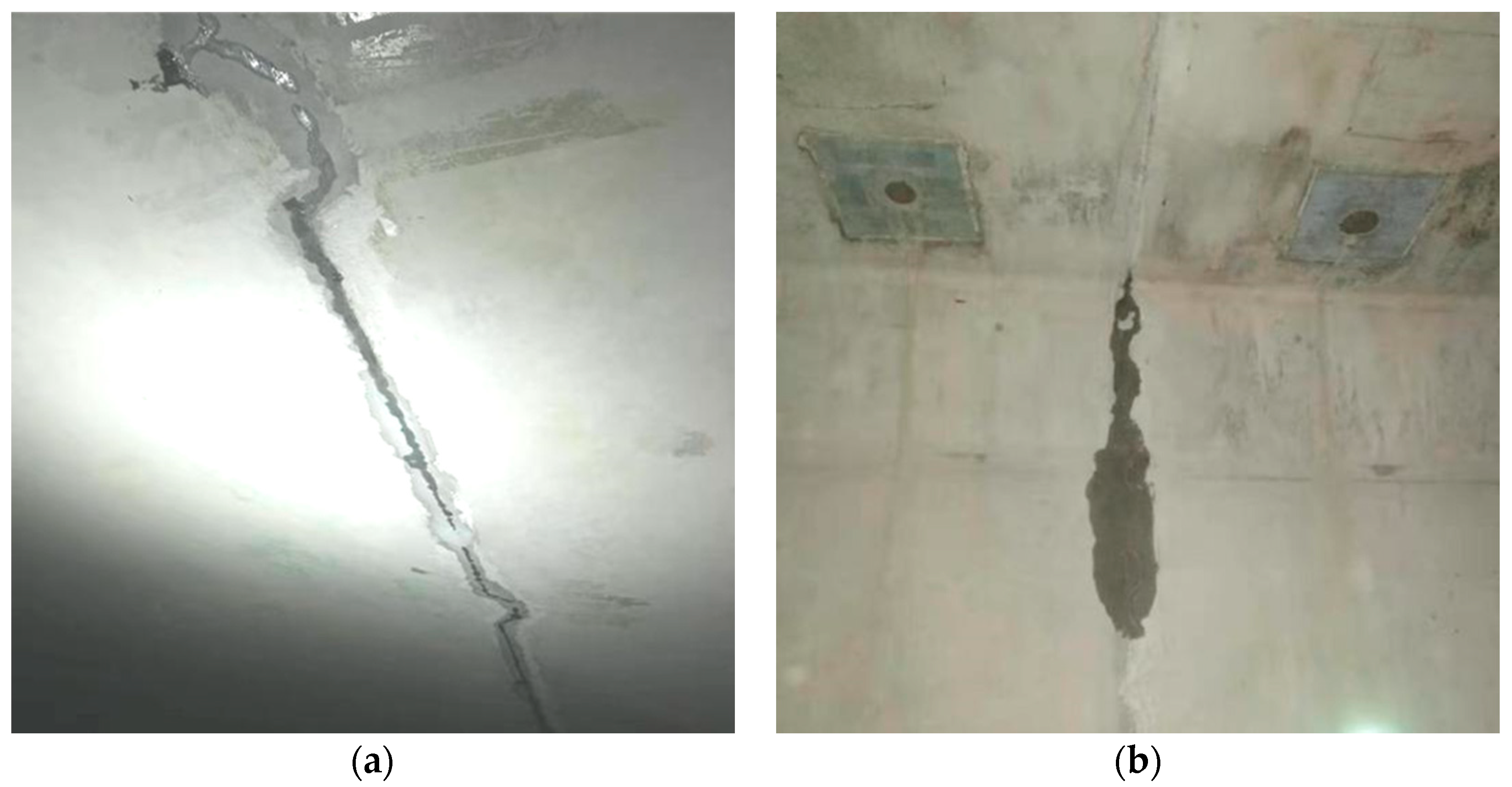
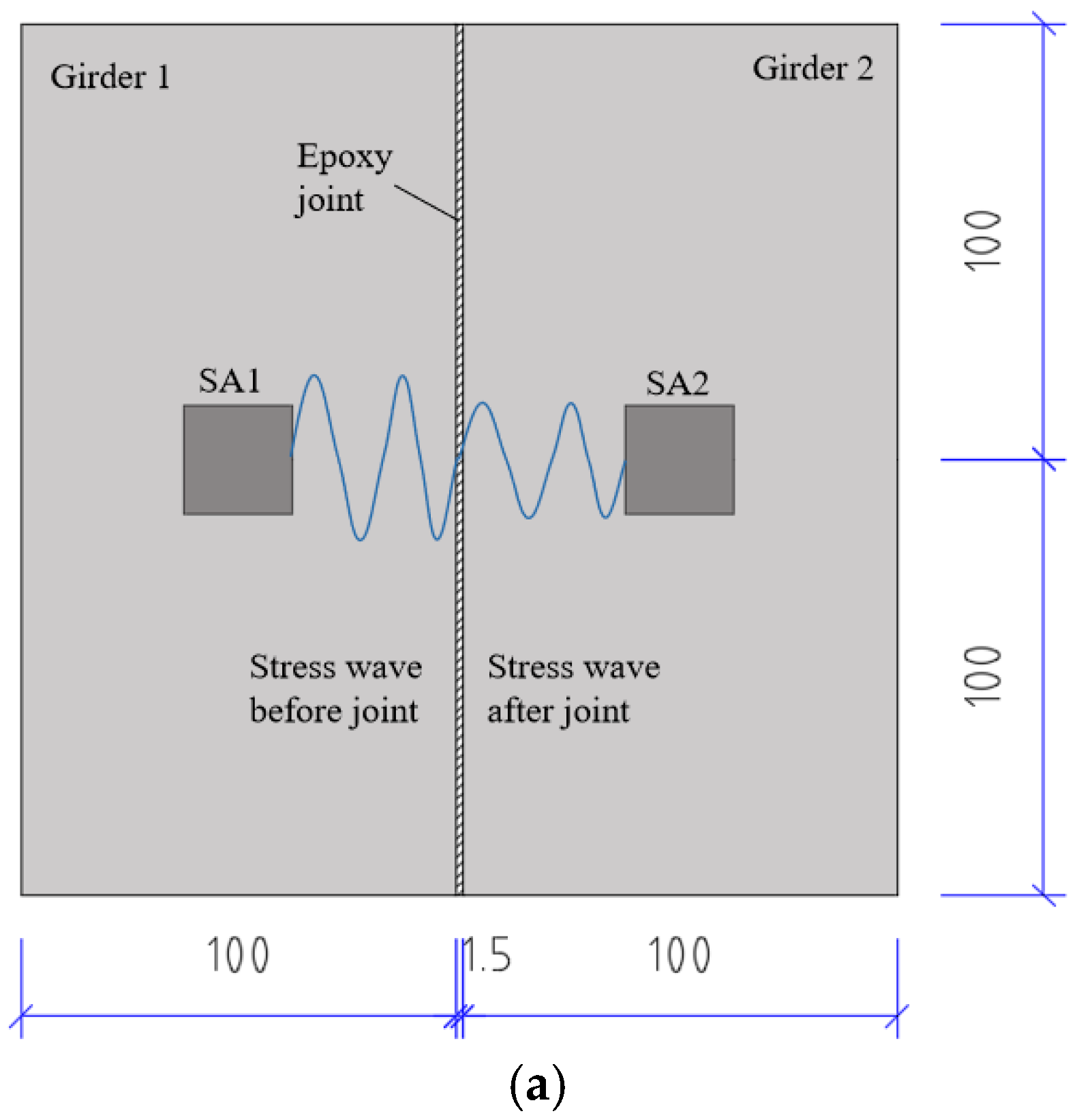
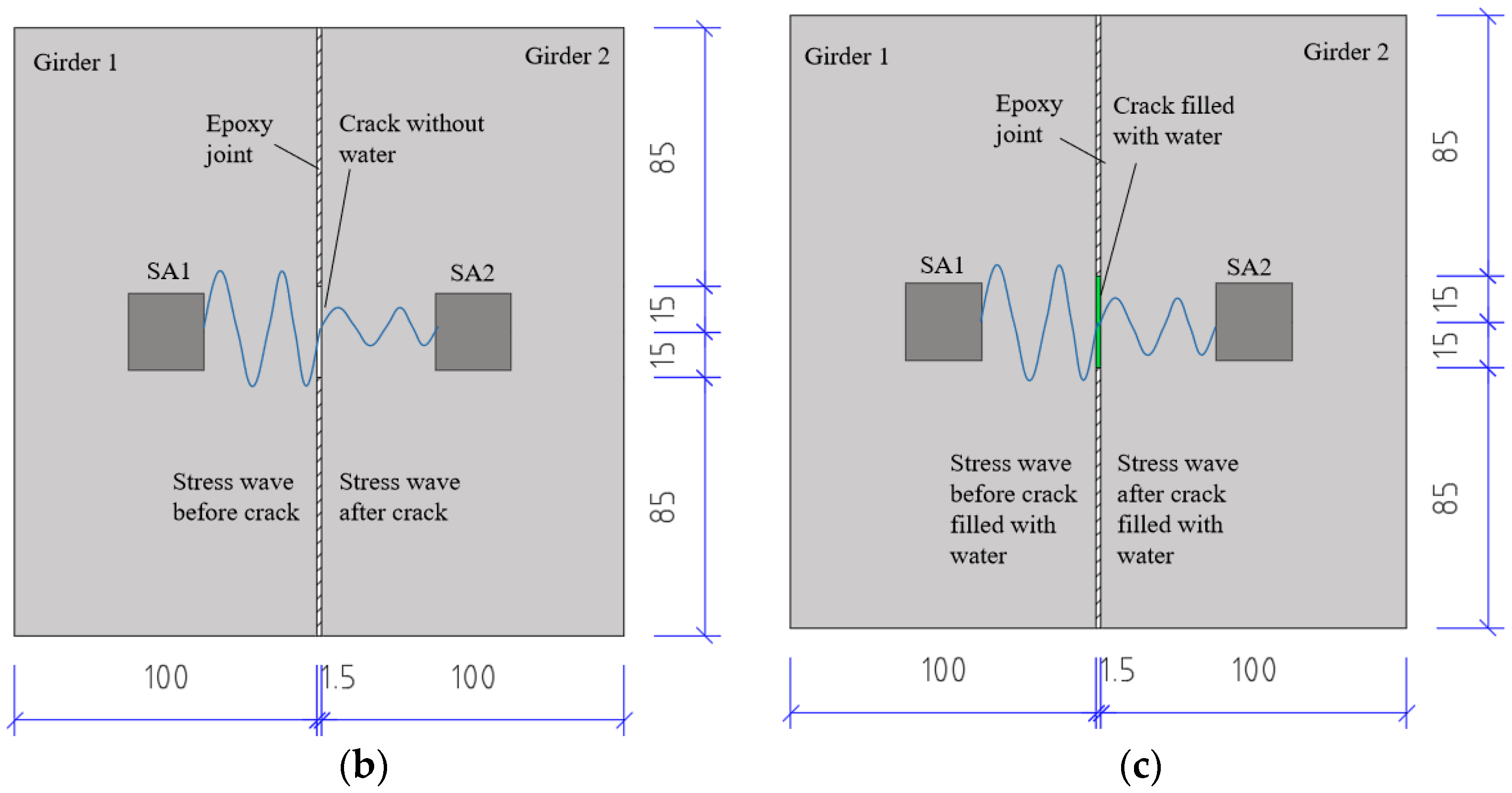
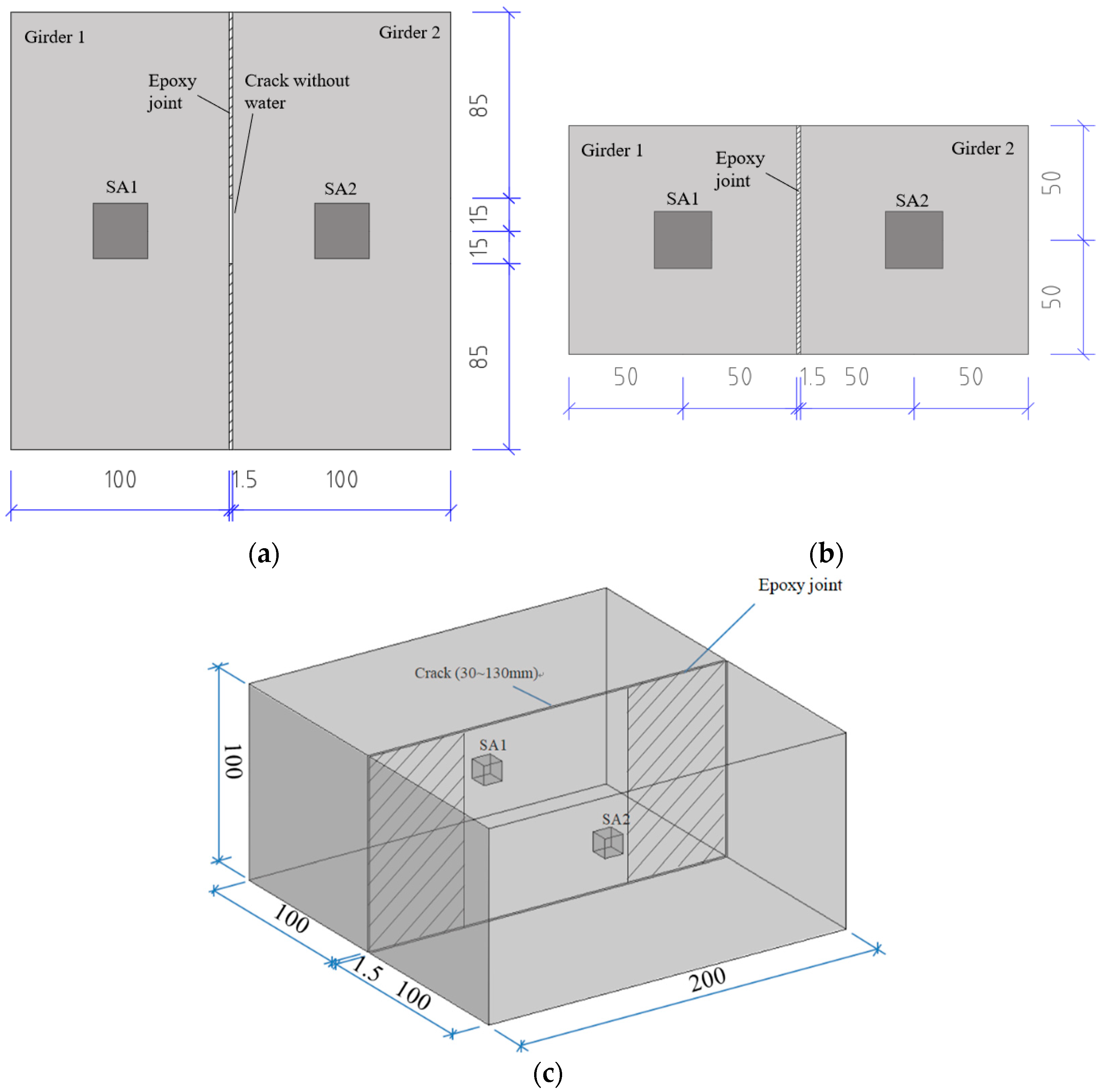
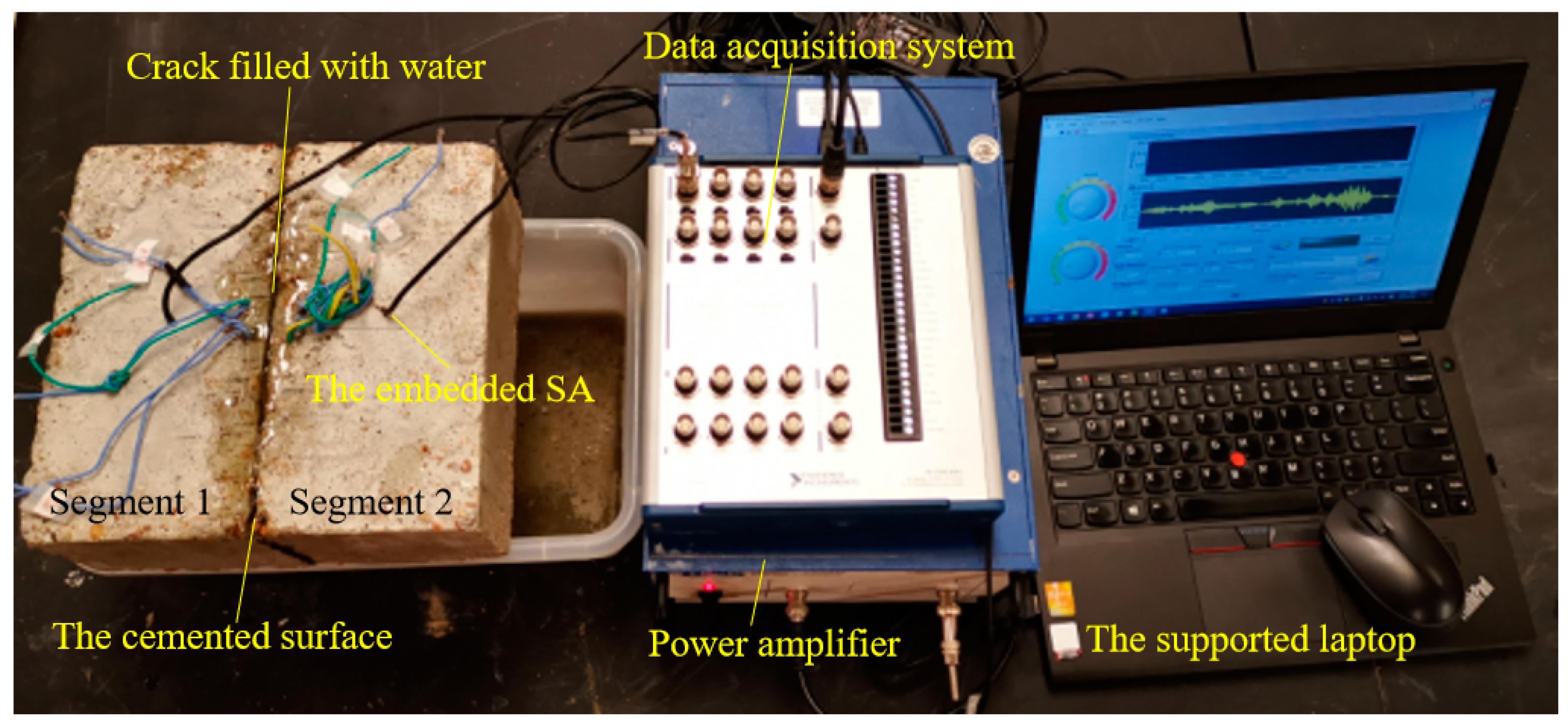

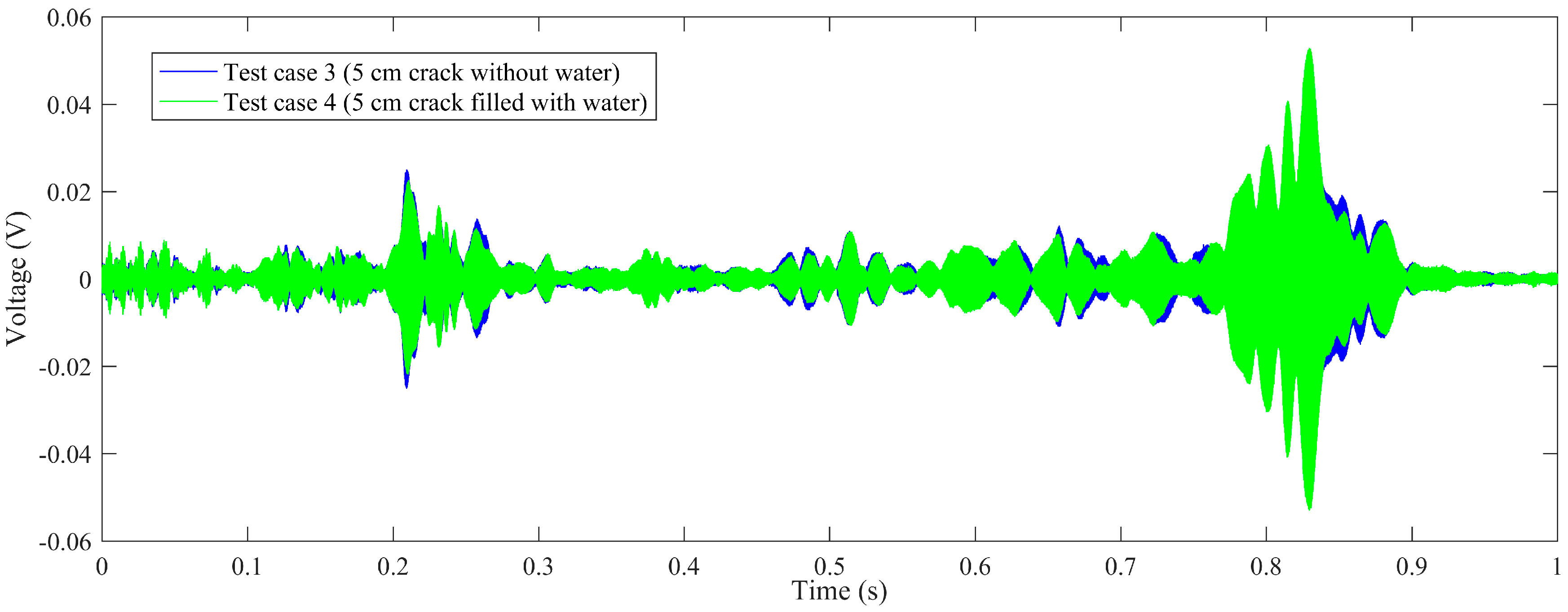
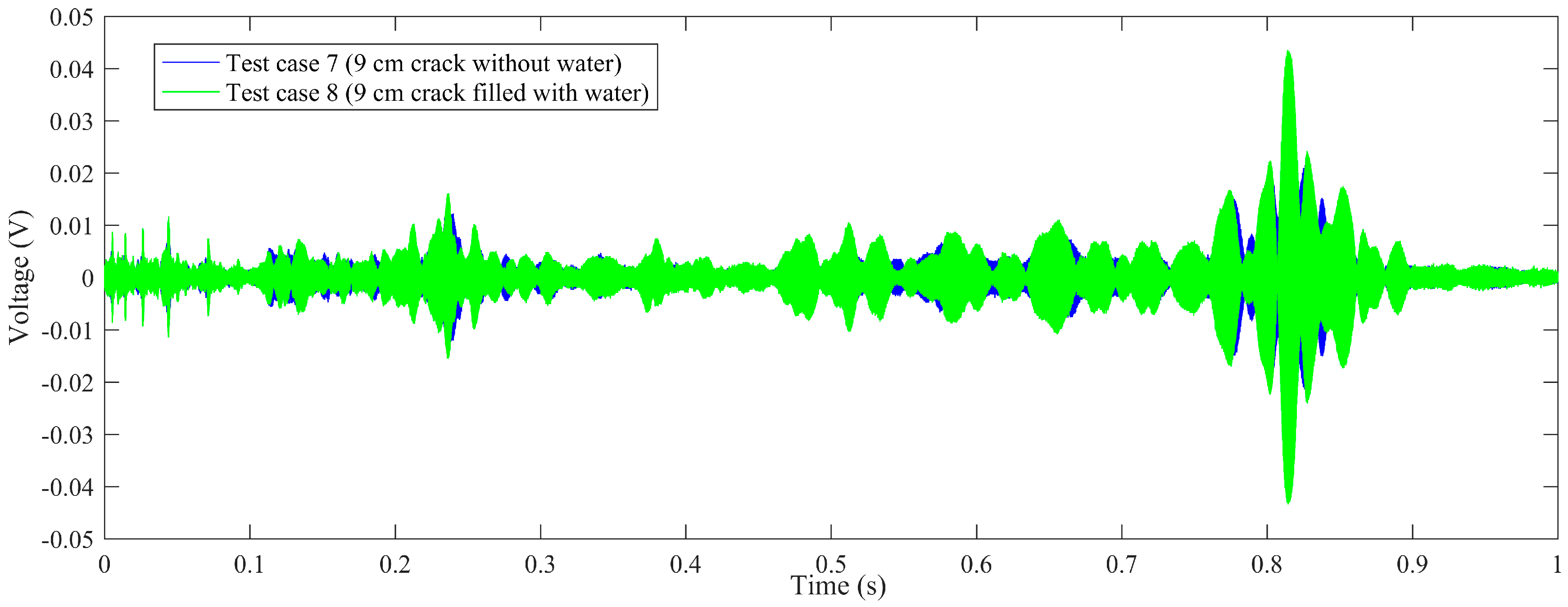
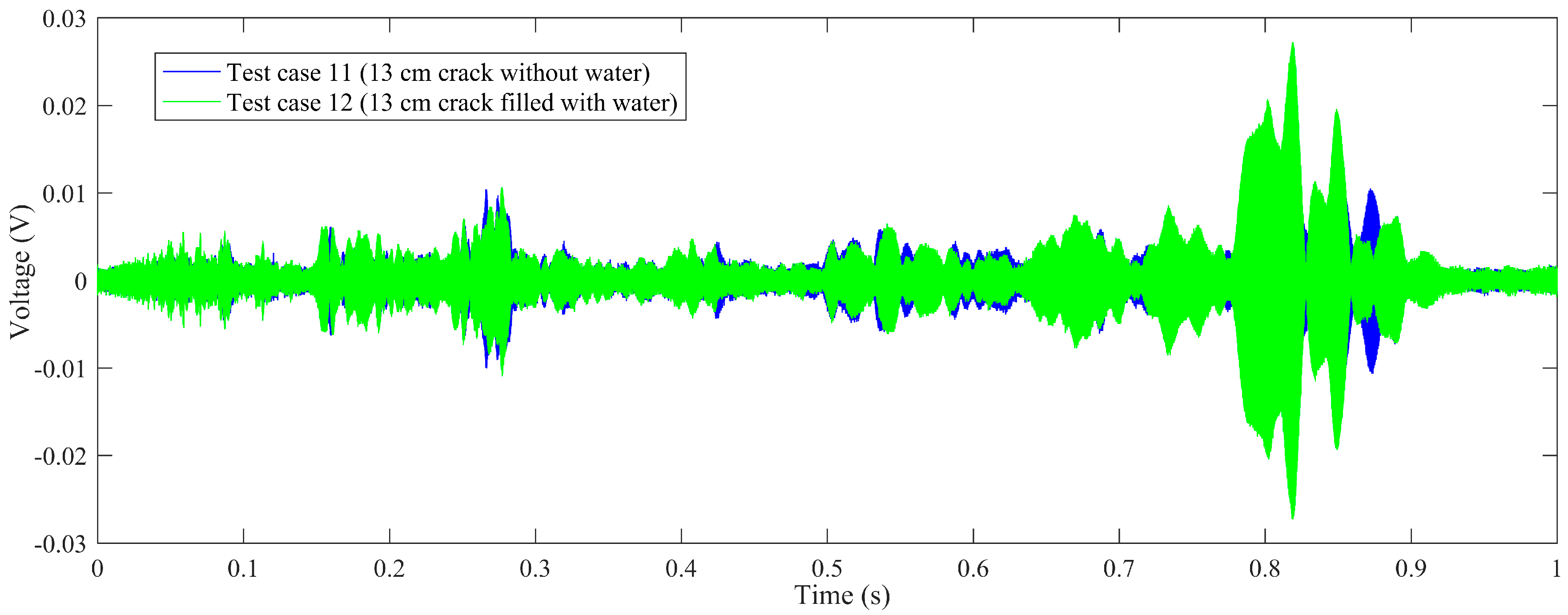
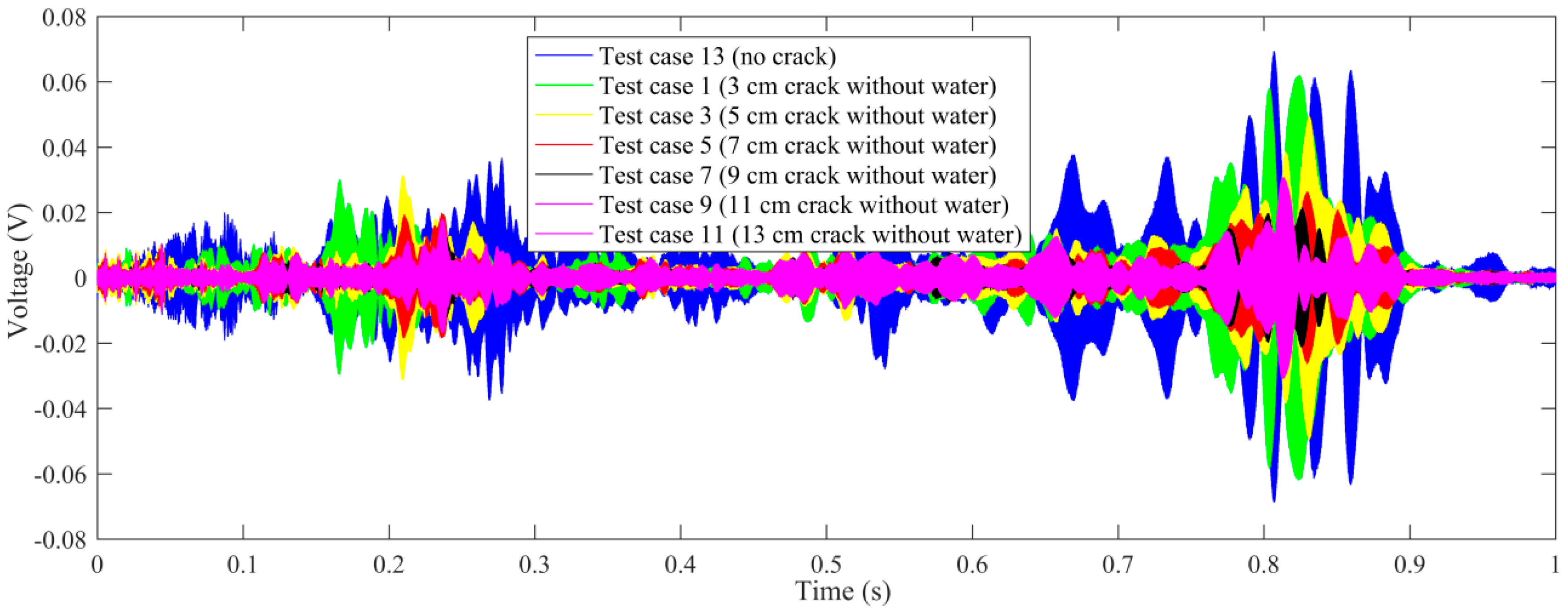
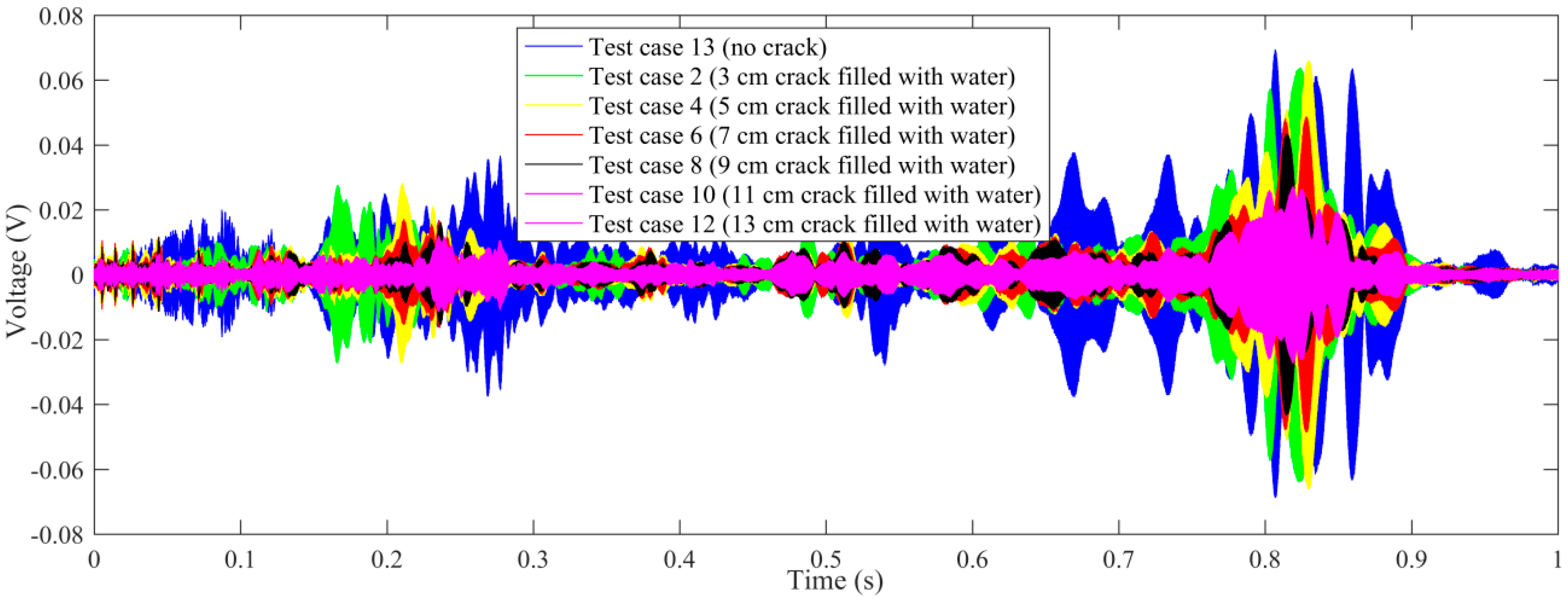
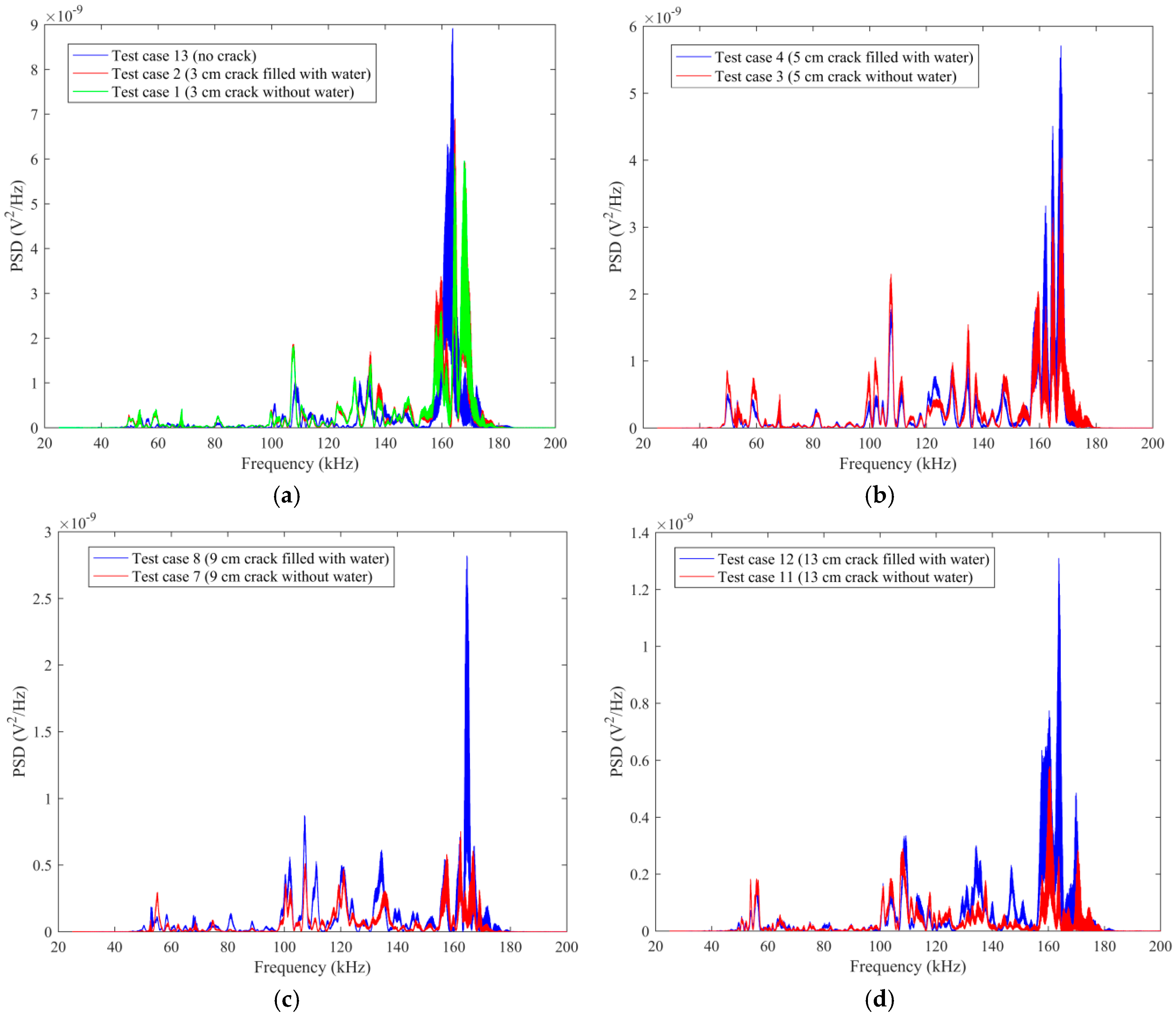
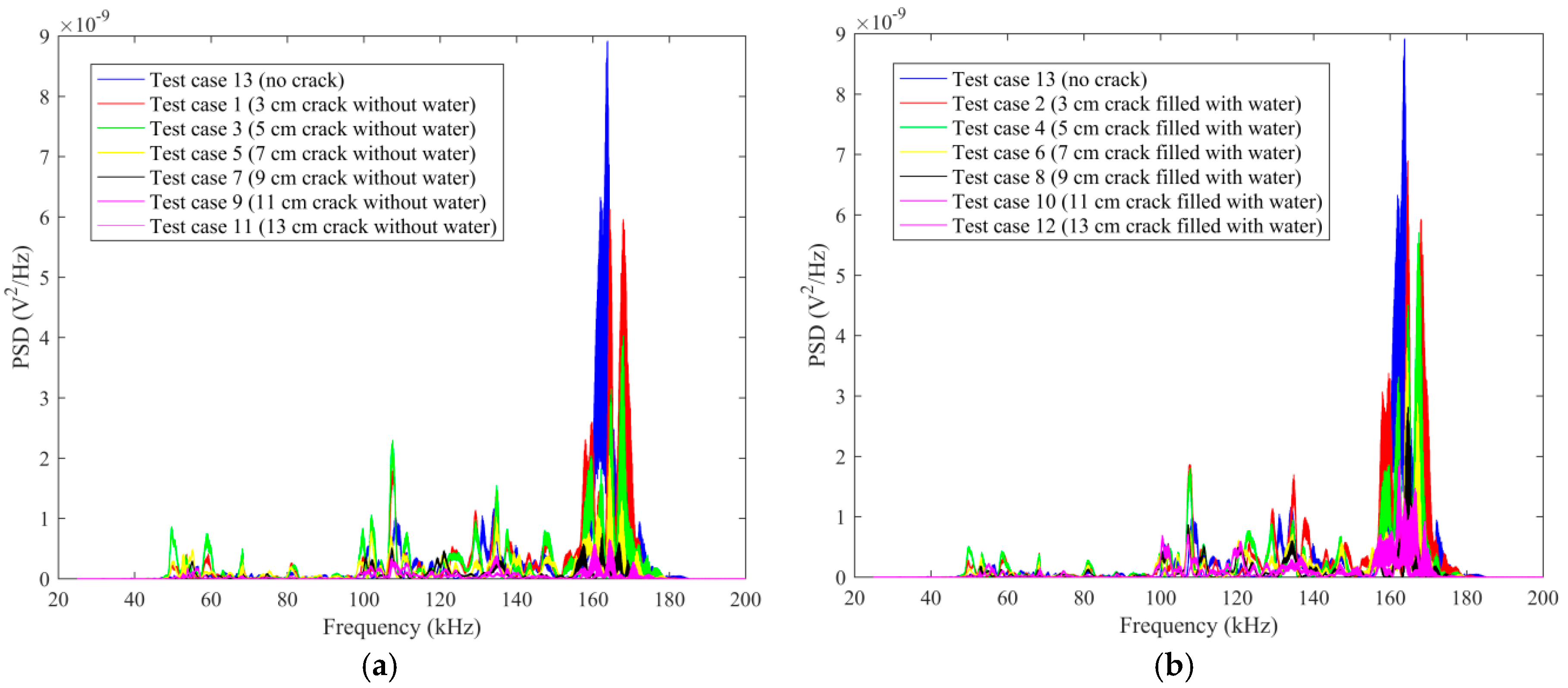
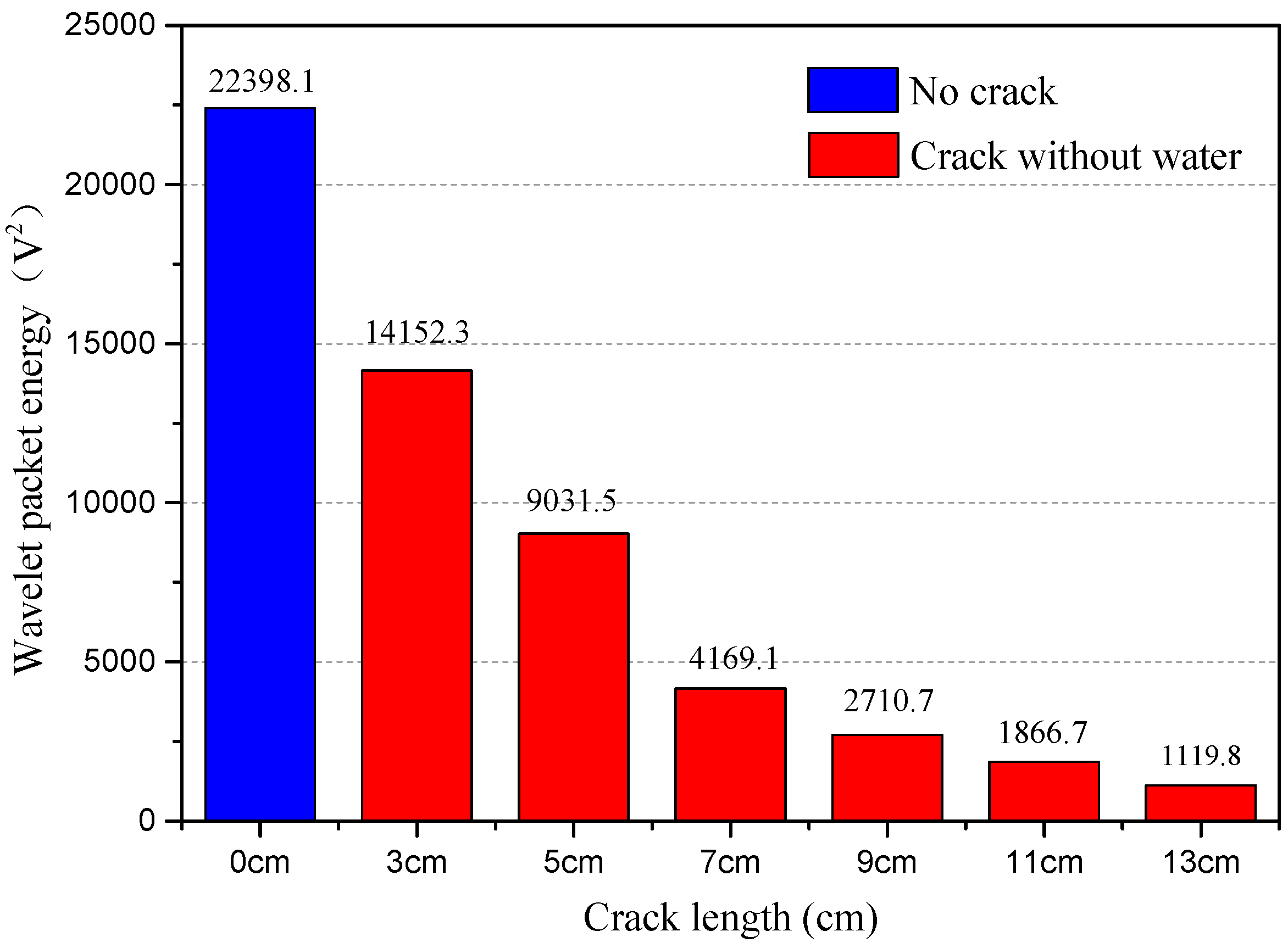
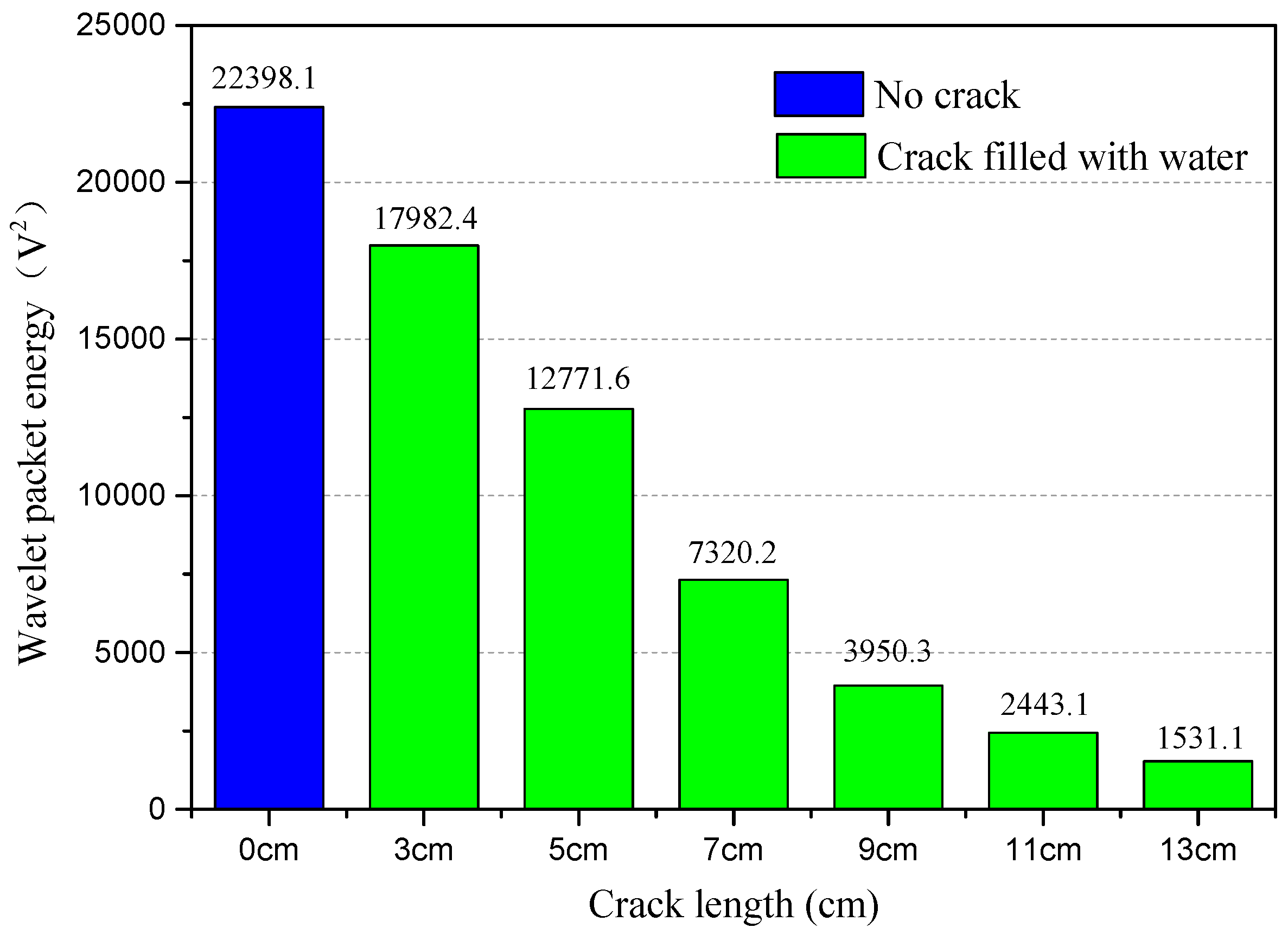
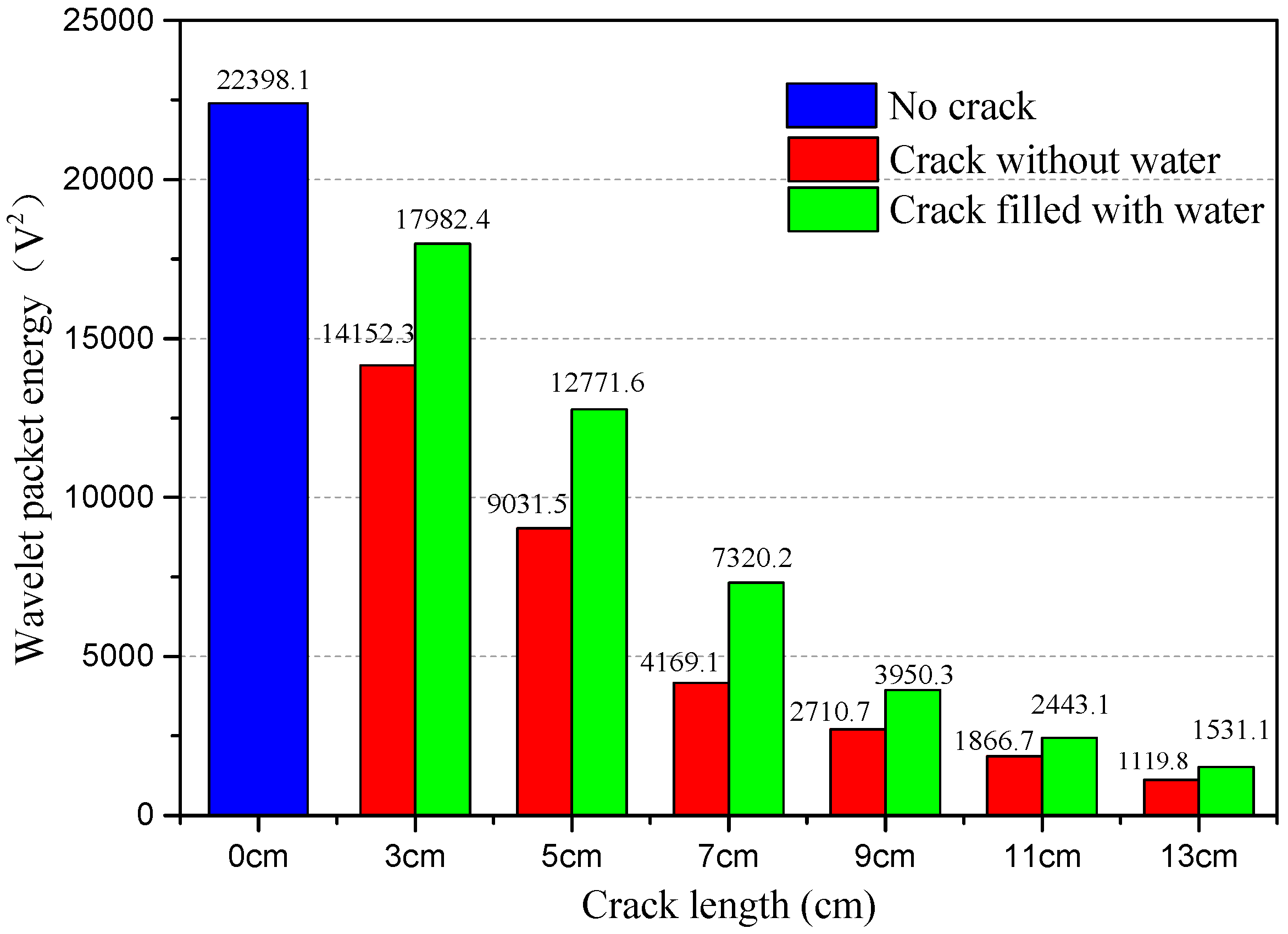
| Materials | Parameters | Value | Units |
|---|---|---|---|
| Concrete | Density | 2422 | kg/m3 |
| Young’s modulus | 34.2 | Gpa | |
| Poisson’s ratio | 0.17 | / | |
| Epoxy | Density | 1250 | kg/m3 |
| Young’s modulus | 3.5 | Gpa | |
| Poisson’s ratio | 0.1 | / | |
| SA | Dimension | 25 × 25 × 25 | mm |
| Piezoelectric strain coefficients (d33) | 4.00 | 10−10 C/N |
| Test Case | 1 | 2 | 3 | 4 | 5 | 6 | 7 | 8 | 9 | 10 | 11 | 12 | 13 |
|---|---|---|---|---|---|---|---|---|---|---|---|---|---|
| Crack length (cm) | 3 | 3 | 5 | 5 | 7 | 7 | 9 | 9 | 11 | 11 | 13 | 13 | 0 |
| Filled with water | N | Y | N | Y | N | Y | N | Y | N | Y | N | Y | - |
| Parameters | Initial Frequency (Hz) | Final Frequency (Hz) | Duration (s) | Amplitude (V) | Input Rate (Hz) | Onput Rate (Hz) |
|---|---|---|---|---|---|---|
| Value | 1000 | 200,000 | 1 | 3 | 2,000,000 | 2,000,000 |
© 2020 by the authors. Licensee MDPI, Basel, Switzerland. This article is an open access article distributed under the terms and conditions of the Creative Commons Attribution (CC BY) license (http://creativecommons.org/licenses/by/4.0/).
Share and Cite
Wang, J.; Fan, Z. Detecting of the Crack and Leakage in the Joint of Precast Concrete Segmental Bridge Using Piezoceramic Based Smart Aggregate. Sensors 2020, 20, 5398. https://doi.org/10.3390/s20185398
Wang J, Fan Z. Detecting of the Crack and Leakage in the Joint of Precast Concrete Segmental Bridge Using Piezoceramic Based Smart Aggregate. Sensors. 2020; 20(18):5398. https://doi.org/10.3390/s20185398
Chicago/Turabian StyleWang, Jianqun, and Zhe Fan. 2020. "Detecting of the Crack and Leakage in the Joint of Precast Concrete Segmental Bridge Using Piezoceramic Based Smart Aggregate" Sensors 20, no. 18: 5398. https://doi.org/10.3390/s20185398
APA StyleWang, J., & Fan, Z. (2020). Detecting of the Crack and Leakage in the Joint of Precast Concrete Segmental Bridge Using Piezoceramic Based Smart Aggregate. Sensors, 20(18), 5398. https://doi.org/10.3390/s20185398






